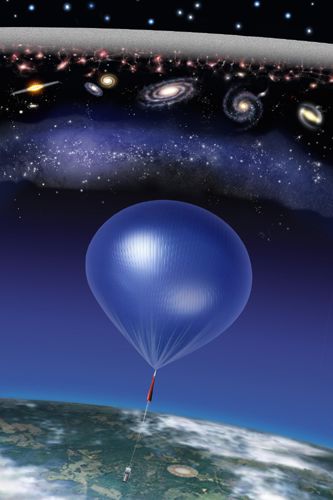by Larry
February, 2014"...and Sail Along the Silver Sky*"
Balloon-based astronomy actually began over a hundred years ago with a launch in 1912 by Victor Hess, who thereby gained evidence for cosmic rays originating off our planet. Besides astronomy, high altitude balloons have been important in the fields of atmospheric pollution, physics, weather, military intelligence, and climatology. Balloons have been crucial in the science of gamma-ray and x-ray astronomy, neutrons emitted from the Sun, supernovae, atmospheric aerosols, airborne radioactive fallout (as well as nuclear emulsions) from atomic and hydrogen bomb detonations, and infrared wavelengths. Though on occasion scientists have responded quickly with a balloon launch to investigate a rapidly developing phenomenon such as the progression of a newly discovered supernova, it can take two to three years to prepare the experimental payload for a sophisticated balloon research flight. While this may seem a long wait, typically the payload projects for scientific rocketry can take a decade or more to "get off the ground." A modern balloon research flight can be expensive, for instance around $400,000 for the combined expendable balloon and its buoyant, inflating gas, plus the costs for the payload itself and the pay for those involved in the start to finish endeavor. Thus it is not unreasonable to figure on a million dollar or more overall investment for each successful balloon launch. This, however, is pennies on the dollar compared with the expenditure for successful space research via modern rockets and satellites. Typical astronomy research balloons are huge, encompassing 50,000 to as much as 600,000 cubic meter volumes. Safety precautions and great care are essential in the launch, which can take many hours till the balloon is off the ground and in its intended location and altitude. Research ballons usually must reach around 30 km up, i.e. approximately 19 miles. At that distance above Earth's surface, air pressure is about one two-hundredths what it is at sea level. With so few air molecules, research can be done that is similar to that in space itself. Conditions are not as perfectly astronomical as from satellites, but nearly so. Research balloons as currently constructed lose their helium relatively quickly. Thus their payload researches can normally only be conducted between one and three days before the balloons begin to lose altitude. The longest balloon experiments lasted for 22 days, a rarity. Japanese and U.S. space agencies are developing "super-pressure" balloons. It is hoped they will remain at proper altitudes for up to several months at a time, clearly making them still more competitive with satellites for their research potentials. Meanwhile, though, there is no dearth of pending researches and payloads for existing astronomy balloon technologies. They are sure to continue flying "up, up and away*" in the foreseeable future. Primary source: Sky High Astronomy. Ravi Sood in Cosmos Magazine, Issue 49; April 3, 2013. (*with appreciation to Wikipedia for recreating writer Jimmy Webb's lyrics of "Up, Up and Away," made famous by The Fifth Dimension) |
